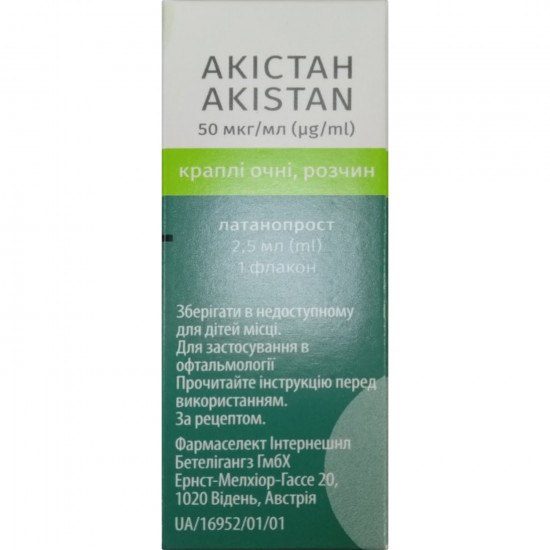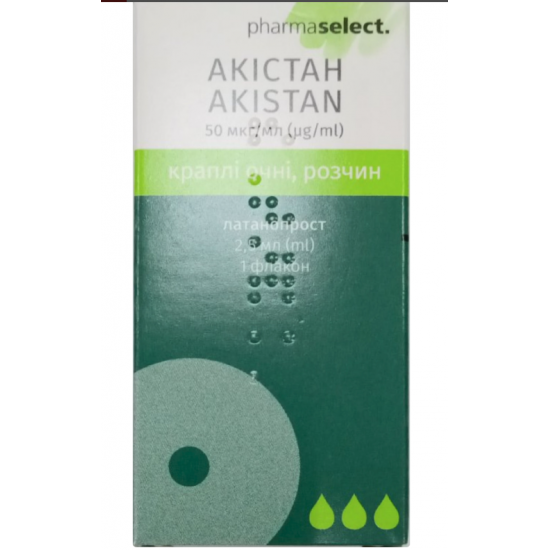





- Stock: In Stock
- Model: se56786789sese
0% Customers recommend this product
-
5 Awesome0%
-
4 Great0%
-
3 Average0%
-
2 Bad0%
-
1 Poor0%
Reviews Over Akistan eye drops solution 0.005% dropper bottle 7.5 ml
- (0)
Total Reviews (0)
click here write review to add review for this product.
Report this review.
Description
Trade name Akistan
Active substances Latanoprost
Release form eye drops
The quantity in the package is 1 bottle of 2.5 ml
The primary packaging is a bottle
How to use Eye
Interaction with food Not relevant
Storage temperature from 2°C to 8°C
Sensitivity to light Sensitive
Sign Imported
Origin Chemical
Market status Branded generic
Manufacturer BRUSCHETTINI S.R.L.
Country of manufacture Italy
Applicant Pharmaselect
Terms of release By prescription
Akistan is an anti-glaucoma drug.
Indications for use
Reduction of increased intraocular pressure in patients with open-angle glaucoma and increased intraocular pressure.
Reduction of elevated intraocular pressure in children with elevated intraocular pressure and pediatric glaucoma.
Storage
active substance: latanoprost;
1 ml of eye drops solution contains 50 mcg of latanoprost;
excipients: sodium dihydrogen phosphate, dihydrate; sodium hydrogen phosphate, dodecahydrate; sodium chloride; benzalkonium chloride 10% m/m solution; sodium hydroxide 10% w/v solution and/or phosphoric acid 10% w/v solution; the water is purified.
Contraindication
Hypersensitivity to any component of Akistan is known.
Adverse reactions
Most of the adverse events are related to the organs of vision. Changes in iris pigmentation have been reported.
Infectious and parasitic diseases. Not known: herpetic keratitis.
From the side of the nervous system. Unknown: headache, dizziness.
From the side of the organs of vision. Very often: increased pigmentation of the iris; mild or moderate hyperemia of the conjunctiva, eye irritation (burning with a feeling of "sand in the eyes", itching, tingling and feeling of a foreign body in the eye); changes in eyelashes and pubic hair (increase in length, thickness, pigmentation and quantity) (the vast majority of cases were observed in Japanese patients). Often: transient point epithelial erosions, mostly asymptomatic; blepharitis; pain in the eyes; photophobia. Infrequent: swelling of the eyelids; dry eyes; keratitis; blurred vision; conjunctivitis Rarely: iritis/uveitis (most cases are registered in patients with concomitant factors predisposing to these diseases); macular edema; symptomatic swellings and erosions of the cornea; periorbital edema; the growth of eyelashes in the wrong direction, which sometimes leads to eye irritation; the appearance of an additional row of eyelashes near the excretory ducts of the meibomian glands (distichiasis). Very rare: periorbital changes and eyelid changes leading to deepening of the eyelid fold. Unknown: iris cyst.
Application method
Recommended dose for adults, including the elderly
Recommended therapy: 1 drop in the affected eye once a day. The optimal effect is achieved when using Akistan in the evening.
Akistan should not be used more often than once a day, as the effectiveness of reducing intraocular pressure decreases with more frequent use.
If a dose is missed, treatment should be continued by taking the next dose at the usual time.
As with any eye drops, to reduce possible systemic absorption during instillation, it is recommended to squeeze the lacrimal sac in the area of the medial corner of the eye for 1 minute (lacrimal point occlusion). This must be done immediately after instilling each drop.
Before instilling eye drops, contact lenses should be removed, they can be installed again after 15 minutes.
When using several ophthalmic topical agents, the drugs should be applied with an interval of at least 5 minutes.
Features of application
Use during pregnancy or breastfeeding
The safety of Akistan for use by pregnant women has not been established. Its pharmacological action poses a potential risk for the course of pregnancy, for the fetus or the newborn. Therefore, Akistan should not be used during pregnancy.
Latanoprost and its metabolites can pass into breast milk, so nursing mothers should stop treatment with Akistan or stop breastfeeding.
Children
Akistan eye drops can be used for children with the same dosage as for adults.
Data on the efficacy and safety of latanoprost in the age group under 1 year are very limited. There are no available data on the use of the drug in premature infants (born before the 36th week of pregnancy).
In children from birth to 3 years of age who suffer mainly from primary congenital glaucoma, surgery (eg, trabeculotomy/goniotomy) remains the first-line method.
The safety of using the drug in children for a long period of time has not been established.
The ability to influence the speed of reaction when driving vehicles or other mechanisms
As with the use of other drugs, instillation of eye drops can cause temporary blurring of vision. Until this effect passes, patients should not drive vehicles or operate machinery.
Overdose
In addition to eye irritation and conjunctival hyperemia, no other side effects from the side of the eyes have been recorded with latanoprost overdose.
The following information may be useful in case of accidental ingestion of Akistan. One vial contains 125 mcg of latanoprost. More than 90% is metabolized during the first passage through the liver. Intravenous infusion of the drug at a dose of 3 μg/kg in healthy volunteers did not cause any symptoms, but at a dose of 5.5-10 μg/kg, it caused nausea, abdominal pain, dizziness, increased fatigue, flushing, and increased sweating.
However, when doses of latanoprost that are 7 times higher than the clinical dose of Akistan are used locally in the eyes, bronchostenosis was not observed in patients with moderate bronchial asthma.
In case of an overdose of Akistan, symptomatic treatment should be carried out.
Interaction with other medicinal products and other types of interactions
There are no comprehensive data on the interaction of the drug with other medicinal products.
A paradoxical increase in intraocular pressure was recorded after the simultaneous ocular application of two prostaglandin analogues. Therefore, it is not recommended to use two or more prostaglandins, prostaglandin analogues or their derivatives at the same time.
Studies of the interaction of latanoprost were conducted only in adult patients.
Storage conditions
Store in the refrigerator at a temperature of 2 - 8 °C in the original package to protect from light. Keep out of the reach of children.
After the first opening, store the bottle at a temperature not higher than 25 °C and use within 4 weeks.
The product description is certified by the manufacturer Bruschettini.



















































